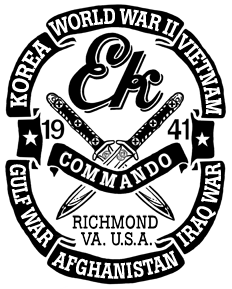
A knife is a tool or weapon with a cutting edge or blade, usually attached to a handle or hilt. One of the earliest tools used by humanity, knives appeared at least 2.5 million years ago, as evidenced by the Oldowan tools. Originally made of wood, bone, and stone, over the centuries, in step with improvements in both metallurgy and manufacturing, knife blades have been made from copper, bronze, iron, steel, ceramic, and titanium. Most modern knives have either fixed or folding blades; blade patterns and styles vary by maker and country of origin.

A blade is the portion of a tool, weapon, or machine with an edge that is designed to puncture, chop, slice or scrape surfaces or materials. Blades are typically made from materials that are harder than those they are to be used on. Historically, humans have made blades from flaking stones such as flint or obsidian, and from various metal such as copper, bronze, and iron. Modern blades are often made of steel or ceramic. Blades are one of humanity's oldest tools, and continue to be used for combat, food preparation, and other purposes.

A Japanese kitchen knife is a type of a knife used for food preparation. These knives come in many different varieties and are often made using traditional Japanese blacksmithing techniques. They can be made from stainless steel, or hagane, which is the same kind of steel used to make Japanese swords. Most knives are referred to as hōchō or the variation -bōchō in compound words but can have other names including -kiri. There are four general categories used to distinguish the Japanese knife designs: handle, blade grind, steel, and construction.

Nakiri bōchō and usuba bōchō are Japanese-style vegetable knives. They differ from the deba bōchō in their shape, as they have a straight blade edge suitable for cutting all the way to the cutting board without the need for a horizontal pull or push. These knives are also much thinner. While the deba bōchō is a heavy blade for easy cutting through thin bones, the blade is not suitable for chopping vegetables, as the thicker blade can break the vegetable slice. The nakiri bōchō and the usuba bōchō have a much thinner blade. This does not help with cutting small bones in fish or meat, but is useful for cutting vegetables.

A kitchen knife is any knife that is intended to be used in food preparation. While much of this work can be accomplished with a few general-purpose knives – notably a large chef's knife, a tough cleaver, a small paring knife and some sort of serrated blade – there are also many specialized knives that are designed for specific tasks. Kitchen knives can be made from several different materials.
In cooking, a chef's knife, also known as a cook's knife, is a cutting tool used in food preparation. The chef's knife was originally designed primarily to slice and disjoint large cuts of beef. Today it is the primary general-utility knife for most Western cooks.

The Santoku bōchō or Bunka bōchō (文化包丁) is a general-purpose kitchen knife originating in Japan. Its blade is typically between 13 and 20 cm long, and has a flat edge and a sheepsfoot blade that curves down an angle approaching 60 degrees at the point. The term Santoku may refer to the wide variety of ingredients that the knife can handle: meat, fish and vegetables, or to the tasks it can perform: slicing, chopping and dicing, either interpretation indicating a multi-use, general-purpose kitchen knife. The Santoku's blade and handle are designed to work in harmony by matching the blade's width and weight to the weight of the tang and the handle.
Wüsthof is a knife-maker based in Solingen, Germany. Family owned for seven generations, the company's main products are mid-priced to high-end kitchen knives for domestic and professional use. Wüsthof is one of the leading manufacturers of chef's knives.
Spyderco is an American cutlery company based in Golden, Colorado, producing knives and knife sharpeners. Spyderco pioneered many features that are now common in folding knives, including the pocket clip, serrations, and the opening hole. Spyderco has collaborated with 30 custom knife makers, athletes, and self-defense instructors for designs and innovated the usage of 20 different blade materials.

Sharpening is the process of creating or refining the edge joining two non-coplanar faces into a converging apex, thereby creating an edge of appropriate shape on a tool or implement designed for cutting. Sharpening is done by removing material on an implement with an abrasive substance harder than the material of the implement, followed sometimes by processes to polish/hone the sharp surface to increase smoothness.

Knife making is the process of manufacturing a knife by any one or a combination of processes: stock removal, forging to shape, welded lamination or investment cast. Typical metals used come from the carbon steel, tool, or stainless steel families. Primitive knives have been made from bronze, copper, brass, iron, obsidian, and flint.

Knife sharpening is the process of making a knife or similar tool sharp by grinding against a hard, rough surface, typically a stone, or a flexible surface with hard particles, such as sandpaper. Additionally, a leather razor strop, or strop, is often used to straighten and polish an edge.

W.R. Case & Sons Cutlery Company is an American manufacturer of traditional pocket knives, fixed blades/sporting knives, kitchen knives, limited edition commemoratives and collectibles. The company originated in Little Valley, New York, around the turn of the 20th century, before relocating to its current home, Bradford, Pennsylvania, in 1905. The company's namesake, William Russell Case, first made knives with his brothers under the name Case Brothers Cutlery Company. His son, John Russell ("Russ") Case, worked as a salesman for his father's company before founding W.R. Case & Sons.
Honyaki (本焼) is the name for the Japanese traditional method of metalwork construction most often seen in kitchen knives by forging a blade, with a technique most similar to the tradition of nihonto, from a single piece of high-carbon steel covered with clay to yield upon quench a soft, resilient spine, a hamon, and a hard, sharp edge. Honyaki as a term alone can refer to either mizu honyaki (water-quench) or abura honyaki. The goal is to produce a sharper, longer lasting edge than is usually achievable with the lamination method. The term has been adapted to describe high-end mono-stainless in Japan and carbon blades by non-Japanese bladesmiths that have a hamon but are made with Western steel, heat treat, equipment, finishing, and design.

A tomato knife is a small serrated kitchen knife designed to slice through tomatoes. The serrated edge allows the knife to penetrate the tomatoes’ skin quickly and with a minimum of pressure without crushing the flesh. Many tomato knives have forked tips that allow the user to lift and move the tomato slices after they have been cut.

Ek Commando Knife Co. or Ek Knives is an American combat knife brand produced by several different companies since the original founded by John Ek in 1941. In May 2014 the Ek brand was purchased by Ka-Bar, which began selling its versions of Ek knife designs in 2015. Although not officially issued gear, Ek Knives have seen use by US forces in six major conflicts: World War II, the Korean War, the Vietnam War, the Gulf War, both wars in Afghanistan and the Iraq War. Ek Knives manufactures Bowie-style blades, daggers, and a Fairbairn-Sykes MkII. President Franklin Delano Roosevelt, Clark Gable, and General George S. Patton have been identified as Ek knife owners.

A cheese knife is a type of kitchen knife specialized for the cutting of cheese. Different cheeses require different knives, according primarily to hardness. There are also a number of other kitchen tools designed for cutting or slicing cheese, especially the harder types. These include the cheese cutter, cheese slicer, cheese plane, cheese scoop for soft cheese and others, collectively known as cheese servers.
Chris Reeve Knives is an American knife manufacturing corporation with international sales and distribution headquartered in Boise, Idaho, that designs, develops, and sells folding pocket knives and fixed-blade knives. Its products include the Sebenza, Inkosi, Umnumzaan, TiLock, Mnandi folding knives, Impinda slip joint, and the Green Beret, Pacific, Professional Soldier, Nyala, and Sikayo fixed blade knives. Chris Reeve Knives' industry contributions include the Integral Lock, contributions to the blade steels CPM-S30V and CPM-S35VN, and has won Blade Magazine's Blade Show Manufacturing Quality Award 15 times. Their motto is Think Twice, Cut Once.

A table knife is an item of cutlery with a single cutting edge, and a blunt end – part of a table setting. Table knives are typically of moderate sharpness only, designed to cut prepared and cooked food.

A fillet knife is a kitchen knife used for filleting. It gives good control and aids in filleting. It is a very flexible member of the boning knife family that is used to filet and prepare fish. Fillet knife blades are typically 15 to 28 cm long. This allows them to move easily along the backbone and under the skin of meat.















